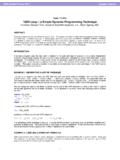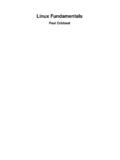Transcription of 158-2010: How to Use Arrays and DO Loops: Do I DO OVER …
1 SAS Global Forum 2010 Hands-on Workshops Paper 158-2010. How to Use Arrays and do loops : Do I DO over or Do I DO i? Jennifer L Waller, Medical College of Georgia, Augusta, GA. ABSTRACT. Do you tend to copy DATA step code over and over and just change the variable? Do you want to learn how to take those hundreds of line of code that essentially do the same operation and reduce them to something that is more efficient? Then come and learn about Arrays and do loops . Arrays and do loops are powerful data manipulation tools that help make code more efficient. In this workshop you will learn when Arrays and DO. loops can and should be used, how to set up an array with and without specifying the number of array elements, and determine what type of DO loop is most appropriate to use within the constraints of the task you want to perform. Additionally, you will learn how to restructure your data set using Arrays and do loops rather than PROC TRANSPOSE. INTRODUCTION. Data preparation can take up to 90-95% of the time dedicated to a statistical analysis consulting project.
2 Rather than making sure statistical assumptions are correct, running the procedures to actually analyze the data, and examining the results, much of the time spent on a project is spent preparing the data for analysis. Often, when preparing a data set for analysis the raw data needs to be manipulated in some way; for example, new variables need to be created, specific questionnaire items need to be reversed, and/or scores need to be calculated. The list can go on and on. What makes the task of preparing a data set for analysis tedious is that many times the same operation needs to be performed on a long list of variables ( questionnaire items). For a beginning SAS programmer, the most likely approach taken to writing the necessary SAS code to write the same code over and over , once for each variable. For example, if there is a 100 item questionnaire and 10 items need to be reversed, the code to reverse these 10 items results in 10 lines of code, one line for each questionnaire item to reverse.
3 Needless to say, there ends up being a lot of copying and pasting of the same code and then changing the code for each variable of interest. How can a beginning SAS programmer write less SAS code for this type of data preparation that is also more efficient? One way is to use SAS Arrays and do loops . SAS Arrays . A SAS array is a set of variables of the same type that you want to perform the same operation on. The set of variables is then referenced in the DATA step by the array name. The variables in the array are called the elements . of the array . Arrays can be used to do all sorts of things. To list just a few, an array can be used to 1. Set up a list of items of a questionnaire that need to be reversed 2. Change values of several variables, change a value of Not Applicable to missing for score calculation purposes 3. Create a set of new variables from an existing set of variables, dichotomizing ordinal or continuous variables. For example, assume we have collected data on the Centers for Epidemiologic Studies Depression (CES-D) scale, a 20-item questionnaire.
4 Each questionnaire item is measured on an ordinal 0 to 3 scale. An overall CESD-D score needs to be calculated and consists of the sum of the 20 questionnaire items. However, 4 questionnaire items were asked in that the responses to the items need to be reversed; that is, 0 needs to become a 3, 1 needs to become a 2, 2 needs to become a 1 and 3 needs to become a 0 for each of these four items. The four items that need to be reversed are items cesd4, cesd8, cesd12, and cesd16. An example of the data is given in Figure 1. Figure 1: Raw CES-D data 1. SAS Global Forum 2010 Hands-on Workshops CESD CESD CESD CESD CESD CESD CESD CESD. Obs ID CESD1 2 3 4 5 6 7 8 9 CESD10 CESD11. 1 1101 2 3 2 . 3 2 2 3 3 2 1. 2 1102 0 2 3 0 2 2 2 1 0 0 2. 3 1103 3 0 2 3 2 1 2 3 1 2 1. 4 1104 1 0 0 2 3 3 2 3 3 2 1. 5 1105 3 2 2 . 3 . 3 3 . 2 2. Obs CESD12 CESD13 CESD14 CESD15 CESD16 CESD17 CESD18 CESD19 CESD20. 1 3 3 2 3 3 0 1 3 0. 2 2 2 3 2 3 3 2 1 1. 3 3 2 2 3 3 1 1 0 2. 4 2 2 2 0 3 2 2 2 2.
5 5 3 3 3 3 3 0 0 2 0. You might use the following SAS code to reverse the four items resulting in the output in Figure 2. data cesd;. set ;. cesd4=3-cesd4;. cesd8=3-cesd8;. cesd12=3-cesd12;. cesd16=3-cesd16;. Figure 2: CES-D data with items 4, 8, 12, and 16 reversed. CESD CESD CESD CESD CESD CESD. Obs ID CESD1 CESD2 CESD3 4 5 6 7 8 9 CESD10 CESD11. 1 1101 2 3 2 . 3 2 2 0 3 2 1. 2 1102 0 2 3 3 2 2 2 2 0 0 2. 3 1103 3 0 2 0 2 1 2 0 1 2 1. 4 1104 1 0 0 1 3 3 2 0 3 2 1. 5 1105 3 2 2 . 3 . 3 0 . 2 2. Obs CESD12 CESD13 CESD14 CESD15 CESD16 CESD17 CESD18 CESD19 CESD20. 1 0 3 2 3 0 0 1 3 0. 2 1 2 3 2 0 3 2 1 1. 3 0 2 2 3 0 1 1 0 2. 4 1 2 2 0 0 2 2 2 2. 5 0 3 3 3 0 0 0 2 0. Notice that the code to reverse each of the four items is essentially the same with the only difference being the variable name of the item needing to be reversed. Copying code that performs the same operation for a small number of variables is not that big of a problem. However, what if the same operation had to be performed on a 100.
6 2. SAS Global Forum 2010 Hands-on Workshops variables? It would be very inefficient, and I know I would have an increased likelihood of coding errors, to copy the code 100 times and change the variable name in each line. The solution is to use a SAS array . INDEXED array SYNTAX. There are two types of Arrays that can be specified in SAS. The first is what I call an indexed array and the second is a non-indexed array . All Arrays are set up and accessed only within a DATA step. The syntax for an indexed array is as follows: array arrayname {n} [$] [length] list_of_array_elements;. where array is a SAS keyword that specifies that an array is being defined arrayname a valid SAS name that is not a variable name in the data set. {n} the index used to give the number of elements in the array , optional [$] used to specify if the elements in the array are character variables, the default type is numeric [length] used to define the length of new variables being created in the array , optional list_of_array_elements a list of variables of the same type (all numeric or all character) to be included in the array An indexed array is one in which the number of elements, {n}, is specified when the array is defined.
7 A non-indexed array is one in which the number of elements is not specified and SAS determines the number of elements based on the number of variables listed in the array . You can always use an indexed array , however you can only sometimes, depending on the situation, use a non-indexed array . Remember that the arrayname must be a valid SAS name that is not a variable name in the data set. One tip I can give you to help distinguish an array name from a variable name is to start the arrayname with the letter a . EXAMPLE OF AN INDEXED array . Going back to the example of reversing the CES-D items, the SAS code that would be required to define an indexed array containing the 4 CES-D items that need to be reversed is data cesd;. set ;. array areverse {4} cesd4 cesd8 cesd12 cesd18 ;. In defining this array we first specify the SAS keyword array with areverse the arrayname used to reference the array in future SAS code {4} there are 4 elements that will be in the array [$] not needed as all variables in the array are numeric [length] not needed cesd4 cesd8 cesd12 cesd18 is the list of the variables that specify the 4 array elements.
8 3. SAS Global Forum 2010 Hands-on Workshops NON-INDEXED array SYNTAX. In addition to the indexed array , SAS also provides the option of using a non-indexed array . Here you don't specify the number of elements in the array , {n}. Rather, during the creation of the array , SAS determines the number of elements of the array based on the set of variables listed. The syntax for a non-indexed array is as follows: array arrayname [$] [length] list_of_array_elements;. where array is a SAS keyword that specifies that an array is being defined arrayname a valid SAS name that is not a variable name in the data set. [$] used to specify if the elements in the array are character variables, the default type is numeric [length] used to define the length of new variables being created in the array , optional list_of_array_elements a list of variables of the same type (all numeric or all character) to be included in the array EXAMPLE OF A NON-INDEXED array . Again, using the CES-D item reversal example, the SAS code that would be to define a non-indexed array containing the 4 CES-D items that need to be reversed is data cesd.
9 Set ;. array areverse cesd4 cesd8 cesd12 cesd18;. In defining this array we first specify the SAS keyword array with areverse the arrayname used to reference the array in future SAS code cesd4 cesd8 cesd12 cesd18 is the list of the variables that specify the 4 array elements. One great thing about non-indexed Arrays is that they allow for less typing, but give the same functionality in the use of an array . SAS do loops . So we have now defined our Arrays , but now we have to use them to manipulate the data. We use a DO loop to perform the data manipulations on the Arrays . Within a DATA step, a DO loop is used to specify a set of SAS. statements or operations that are to be performed as a unit during an iteration of the loop. It is important to note that operations performed within a DO loop are performed within an observation. Another thing that you need to be aware of is that every DO loop has a corresponding END statement. If you don't END your DO loop, you will get a SAS Error message in your log indicating that a corresponding END statement was not found for the DO statement.
10 There are four different types of do loops available in SAS. 1. DO index=, an iterative, or indexed, DO loop used to perform the operations in the DO loop at a specified start and ending index value for an array 2. DO over loop used to perform the operations in the DO loop over ALL elements in the array 4. SAS Global Forum 2010 Hands-on Workshops 3. DO UNTIL (logical condition) loop used to perform the operations in the DO loop until the logical condition is satisfied 4. DO WHILE (logical condition) loop used to perform the operations in the DO loop while the logical condition is satisfied Many times, do loops are used in conjunction with a SAS array , with the basic idea being that the operations in the DO loop will be performed over all the elements in the array . It should be noted that within a single DO loop multiple Arrays can be referenced and operations on different Arrays can be performed. ITERATIVE DO LOOP DEFINITION AND SYNTAX. An iterative DO loop executes the statements between a DO statement and an END statement repetitively based on the value of the specified starting and stopping values of an index.
















